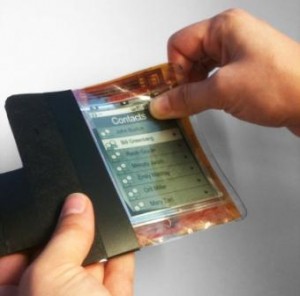 If that smartphone or touch-screen tablet is starting to feel heavy after holding it in mid-air for a few minutes, then help is on the way. New “paper” smartphones and tablets will use flexible plastic displays and electronics light enough to wear. Most of the weight of mobile devices comes from the metal inside, where copper conductor’s shuttle around the electrons that make your smartphone or touch-screen tablet work.
If that smartphone or touch-screen tablet is starting to feel heavy after holding it in mid-air for a few minutes, then help is on the way. New “paper” smartphones and tablets will use flexible plastic displays and electronics light enough to wear. Most of the weight of mobile devices comes from the metal inside, where copper conductor’s shuttle around the electrons that make your smartphone or touch-screen tablet work.
However, by switching from stiff-metal to flexible-plastic conductors, the mobile devices of the future will be feather-light, thinner and less expensive and consume tiny amounts of power compared with today.
The PaperPhone also used its flexibility to control functions, for instance, scrolling to the next page when you flick its upper right corner. The researchers identified multiple “bend gestures,” such as flexing one side forward or backward, that will be used to control actions on the screen.
Many are also predicting that flexible PaperPhones will lead to paper touch-screen tablets and may even eliminate the need for printers, since text and images can merely be loaded onto the flexible displays that everybody is already carrying around in their pockets. This goes to show that technology is always expanding and what is new and hot today will be a thing of the past tomorrow.





Recent Comments